Page 267 of 532
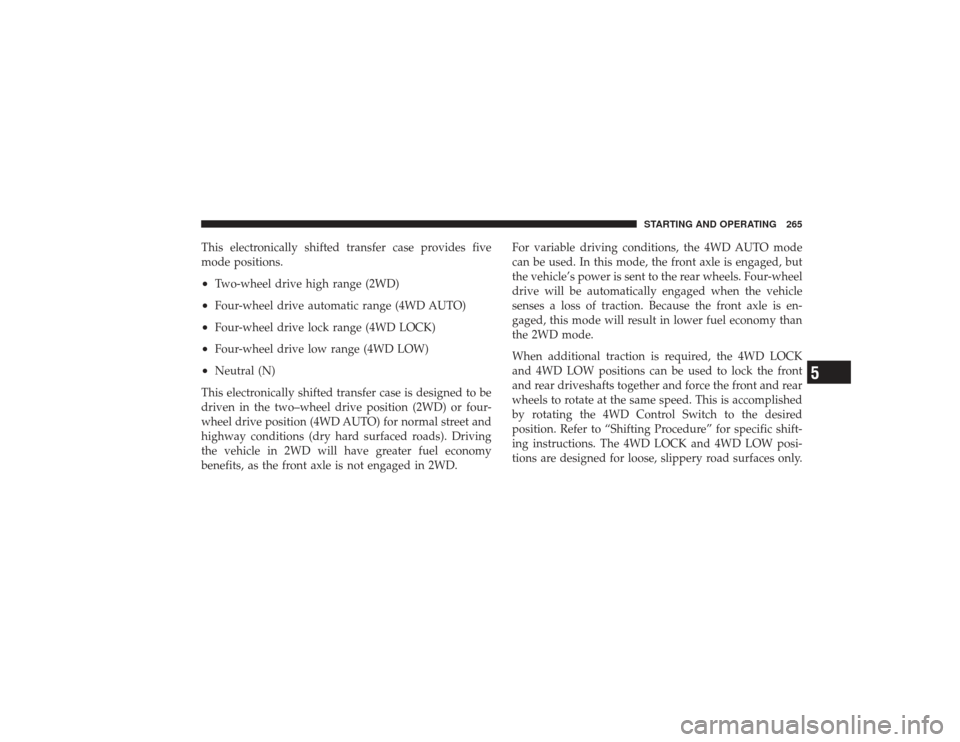
This electronically shifted transfer case provides five
mode positions.•
Two-wheel drive high range (2WD)
•
Four-wheel drive automatic range (4WD AUTO)
•
Four-wheel drive lock range (4WD LOCK)
•
Four-wheel drive low range (4WD LOW)
•
Neutral (N)
This electronically shifted transfer case is designed to be
driven in the two–wheel drive position (2WD) or four-
wheel drive position (4WD AUTO) for normal street and
highway conditions (dry hard surfaced roads). Driving
the vehicle in 2WD will have greater fuel economy
benefits, as the front axle is not engaged in 2WD. For variable driving conditions, the 4WD AUTO mode
can be used. In this mode, the front axle is engaged, but
the vehicle’s power is sent to the rear wheels. Four-wheel
drive will be automatically engaged when the vehicle
senses a loss of traction. Because the front axle is en-
gaged, this mode will result in lower fuel economy than
the 2WD mode.
When additional traction is required, the 4WD LOCK
and 4WD LOW positions can be used to lock the front
and rear driveshafts together and force the front and rear
wheels to rotate at the same speed. This is accomplished
by rotating the 4WD Control Switch to the desired
position. Refer to “Shifting Procedure” for specific shift-
ing instructions. The 4WD LOCK and 4WD LOW posi-
tions are designed for loose, slippery road surfaces only.
STARTING AND OPERATING 265
5
Page 268 of 532
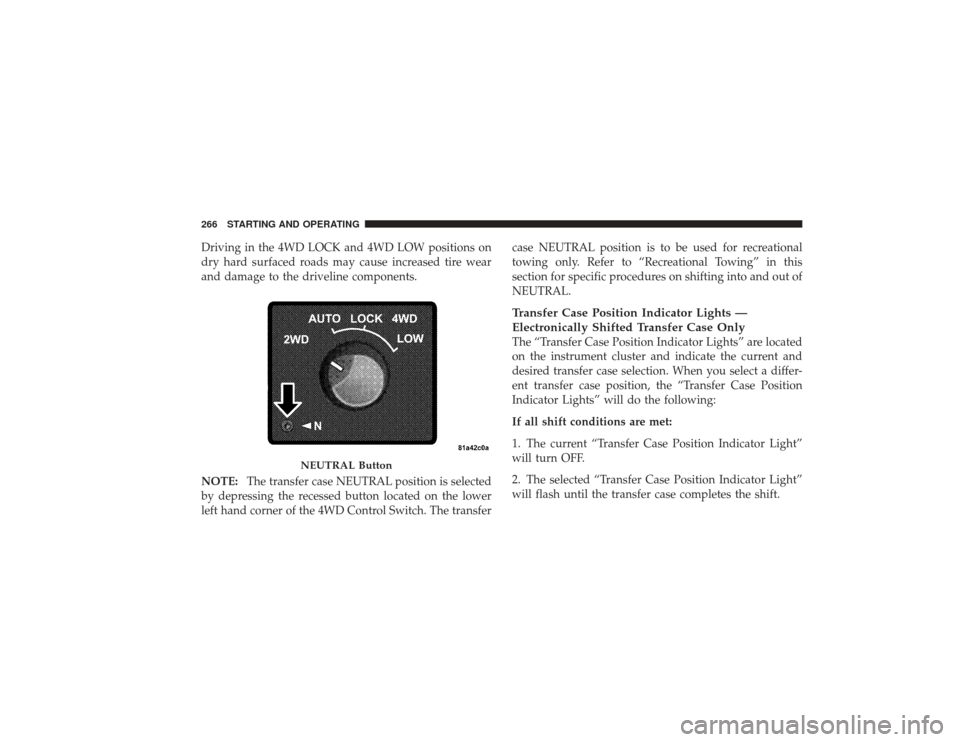
Driving in the 4WD LOCK and 4WD LOW positions on
dry hard surfaced roads may cause increased tire wear
and damage to the driveline components.
NOTE:The transfer case NEUTRAL position is selected
by depressing the recessed button located on the lower
left hand corner of the 4WD Control Switch. The transfer case NEUTRAL position is to be used for recreational
towing only. Refer to “Recreational Towing” in this
section for specific procedures on shifting into and out of
NEUTRAL.
Transfer Case Position Indicator Lights —
Electronically Shifted Transfer Case OnlyThe “Transfer Case Position Indicator Lights” are located
on the instrument cluster and indicate the current and
desired transfer case selection. When you select a differ-
ent transfer case position, the “Transfer Case Position
Indicator Lights” will do the following:
If all shift conditions are met:
1. The current “Transfer Case Position Indicator Light”
will turn OFF.
2. The selected “Transfer Case Position Indicator Light”
will flash until the transfer case completes the shift.
NEUTRAL Button
266 STARTING AND OPERATING
Page 270 of 532
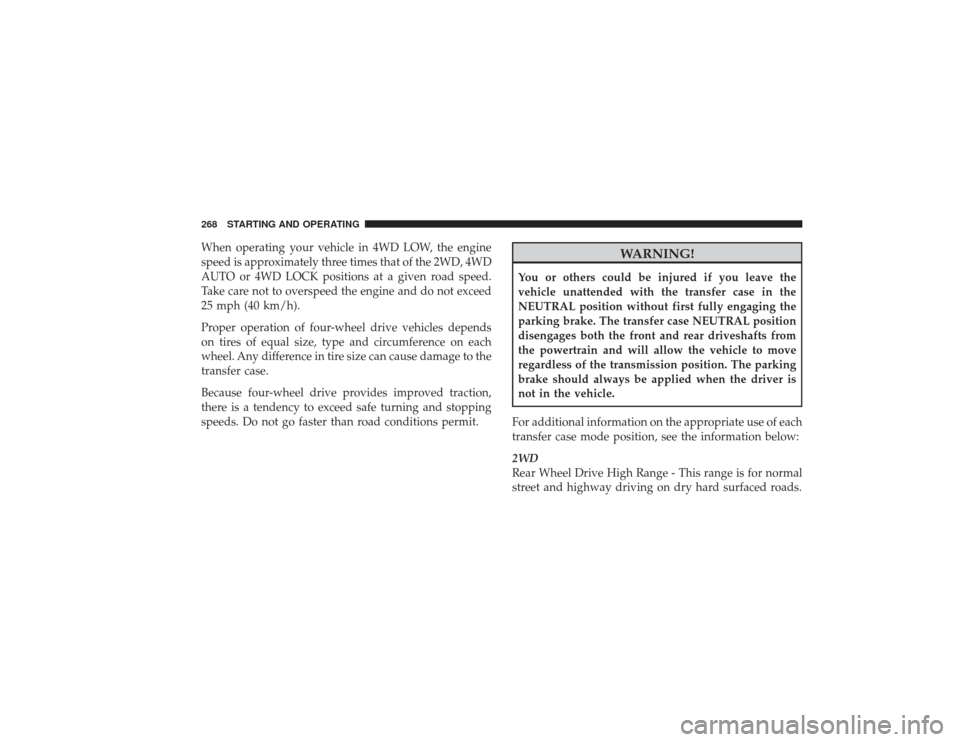
When operating your vehicle in 4WD LOW, the engine
speed is approximately three times that of the 2WD, 4WD
AUTO or 4WD LOCK positions at a given road speed.
Take care not to overspeed the engine and do not exceed
25 mph (40 km/h).
Proper operation of four-wheel drive vehicles depends
on tires of equal size, type and circumference on each
wheel. Any difference in tire size can cause damage to the
transfer case.
Because four-wheel drive provides improved traction,
there is a tendency to exceed safe turning and stopping
speeds. Do not go faster than road conditions permit.
WARNING!
You or others could be injured if you leave the
vehicle unattended with the transfer case in the
NEUTRAL position without first fully engaging the
parking brake. The transfer case NEUTRAL position
disengages both the front and rear driveshafts from
the powertrain and will allow the vehicle to move
regardless of the transmission position. The parking
brake should always be applied when the driver is
not in the vehicle.
For additional information on the appropriate use of each
transfer case mode position, see the information below:
2WD
Rear Wheel Drive High Range - This range is for normal
street and highway driving on dry hard surfaced roads.
268 STARTING AND OPERATING
Page 271 of 532
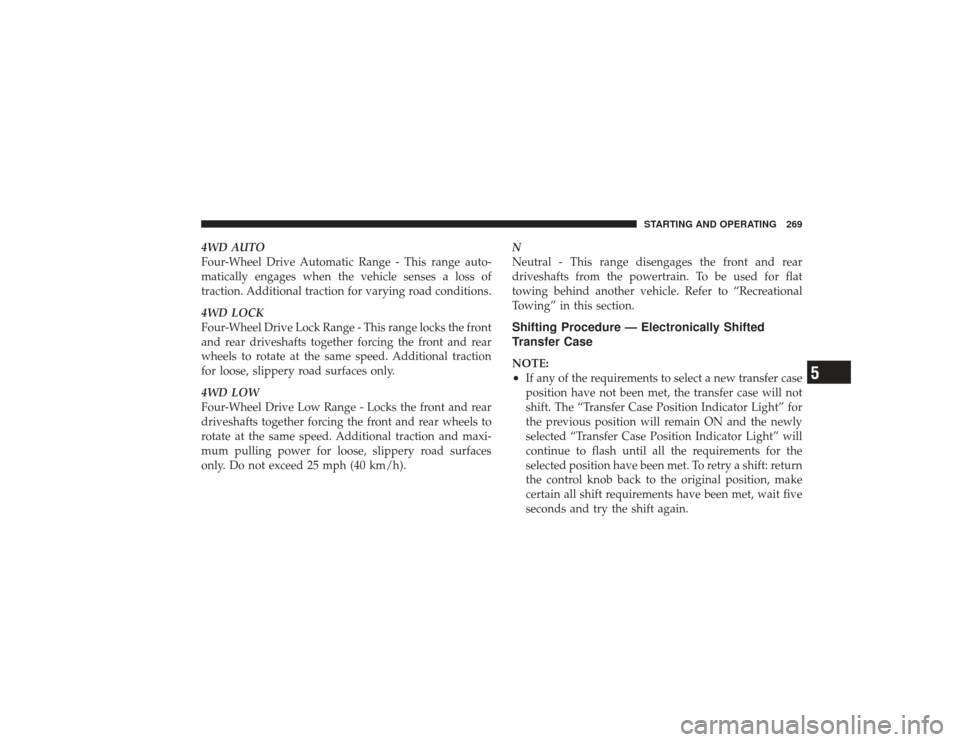
4WD AUTO
Four-Wheel Drive Automatic Range - This range auto-
matically engages when the vehicle senses a loss of
traction. Additional traction for varying road conditions.
4WD LOCK
Four-Wheel Drive Lock Range - This range locks the front
and rear driveshafts together forcing the front and rear
wheels to rotate at the same speed. Additional traction
for loose, slippery road surfaces only.
4WD LOW
Four-Wheel Drive Low Range - Locks the front and rear
driveshafts together forcing the front and rear wheels to
rotate at the same speed. Additional traction and maxi-
mum pulling power for loose, slippery road surfaces
only. Do not exceed 25 mph (40 km/h).N
Neutral - This range disengages the front and rear
driveshafts from the powertrain. To be used for flat
towing behind another vehicle. Refer to “Recreational
Towing” in this section.
Shifting Procedure — Electronically Shifted
Transfer CaseNOTE:•
If any of the requirements to select a new transfer case
position have not been met, the transfer case will not
shift. The “Transfer Case Position Indicator Light” for
the previous position will remain ON and the newly
selected “Transfer Case Position Indicator Light” will
continue to flash until all the requirements for the
selected position have been met. To retry a shift: return
the control knob back to the original position, make
certain all shift requirements have been met, wait five
seconds and try the shift again.
STARTING AND OPERATING 269
5
Page 272 of 532
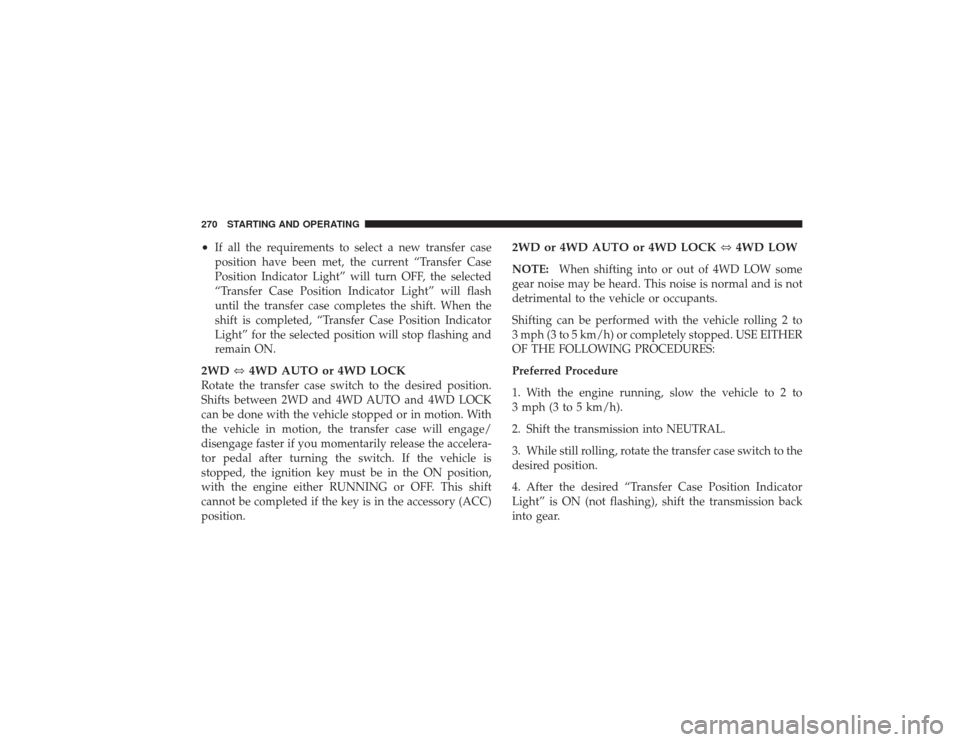
•
If all the requirements to select a new transfer case
position have been met, the current “Transfer Case
Position Indicator Light” will turn OFF, the selected
“Transfer Case Position Indicator Light” will flash
until the transfer case completes the shift. When the
shift is completed, “Transfer Case Position Indicator
Light” for the selected position will stop flashing and
remain ON.
2WD⇔4WD AUTO or 4WD LOCKRotate the transfer case switch to the desired position.
Shifts between 2WD and 4WD AUTO and 4WD LOCK
can be done with the vehicle stopped or in motion. With
the vehicle in motion, the transfer case will engage/
disengage faster if you momentarily release the accelera-
tor pedal after turning the switch. If the vehicle is
stopped, the ignition key must be in the ON position,
with the engine either RUNNING or OFF. This shift
cannot be completed if the key is in the accessory (ACC)
position.
2WD or 4WD AUTO or 4WD LOCK ⇔4WD LOWNOTE: When shifting into or out of 4WD LOW some
gear noise may be heard. This noise is normal and is not
detrimental to the vehicle or occupants.
Shifting can be performed with the vehicle rolling 2 to
3 mph (3 to 5 km/h) or completely stopped. USE EITHER
OF THE FOLLOWING PROCEDURES:
Preferred Procedure
1. With the engine running, slow the vehicle to 2 to
3 mph (3 to 5 km/h).
2. Shift the transmission into NEUTRAL.
3. While still rolling, rotate the transfer case switch to the
desired position.
4. After the desired “Transfer Case Position Indicator
Light” is ON (not flashing), shift the transmission back
into gear.
270 STARTING AND OPERATING
Page 274 of 532
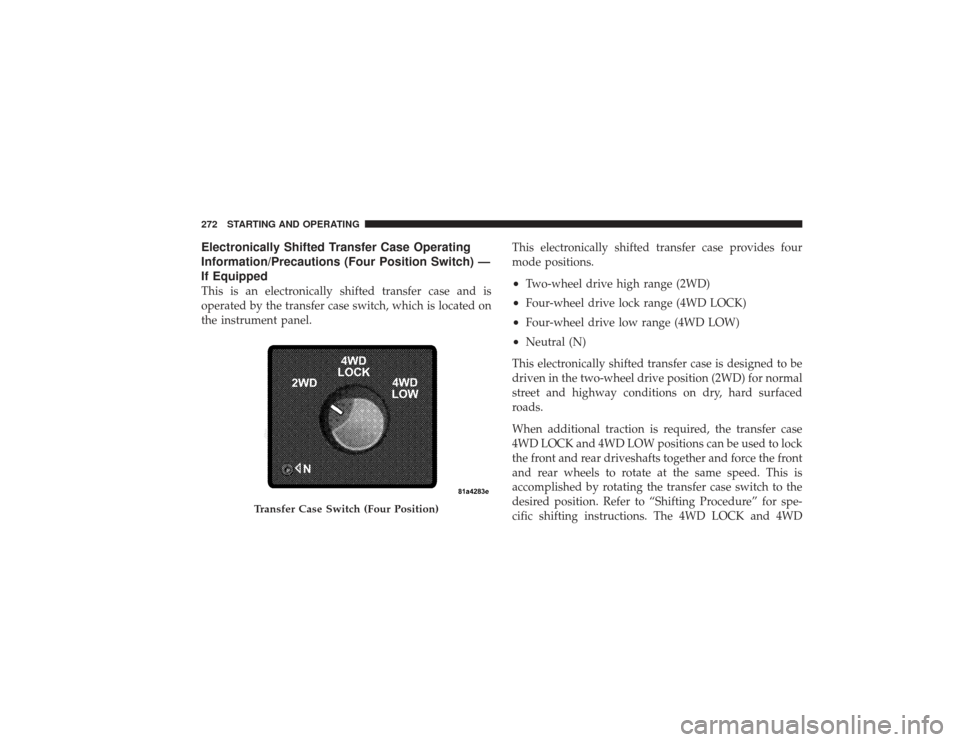
Electronically Shifted Transfer Case Operating
Information/Precautions (Four Position Switch) —
If EquippedThis is an electronically shifted transfer case and is
operated by the transfer case switch, which is located on
the instrument panel.This electronically shifted transfer case provides four
mode positions.
•
Two-wheel drive high range (2WD)
•
Four-wheel drive lock range (4WD LOCK)
•
Four-wheel drive low range (4WD LOW)
•
Neutral (N)
This electronically shifted transfer case is designed to be
driven in the two-wheel drive position (2WD) for normal
street and highway conditions on dry, hard surfaced
roads.
When additional traction is required, the transfer case
4WD LOCK and 4WD LOW positions can be used to lock
the front and rear driveshafts together and force the front
and rear wheels to rotate at the same speed. This is
accomplished by rotating the transfer case switch to the
desired position. Refer to “Shifting Procedure” for spe-
cific shifting instructions. The 4WD LOCK and 4WD
Transfer Case Switch (Four Position)
272 STARTING AND OPERATING
Page 275 of 532
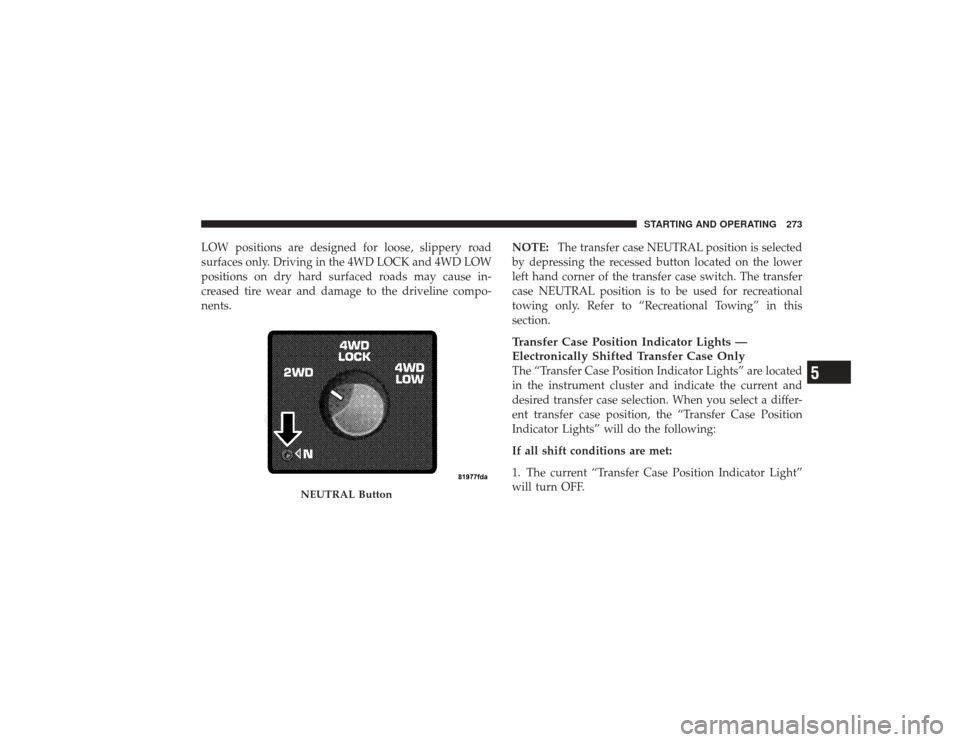
LOW positions are designed for loose, slippery road
surfaces only. Driving in the 4WD LOCK and 4WD LOW
positions on dry hard surfaced roads may cause in-
creased tire wear and damage to the driveline compo-
nents.NOTE:
The transfer case NEUTRAL position is selected
by depressing the recessed button located on the lower
left hand corner of the transfer case switch. The transfer
case NEUTRAL position is to be used for recreational
towing only. Refer to “Recreational Towing” in this
section.
Transfer Case Position Indicator Lights —
Electronically Shifted Transfer Case OnlyThe “Transfer Case Position Indicator Lights” are located
in the instrument cluster and indicate the current and
desired transfer case selection. When you select a differ-
ent transfer case position, the “Transfer Case Position
Indicator Lights” will do the following:
If all shift conditions are met:
1. The current “Transfer Case Position Indicator Light”
will turn OFF.
NEUTRAL Button
STARTING AND OPERATING 273
5
Page 277 of 532
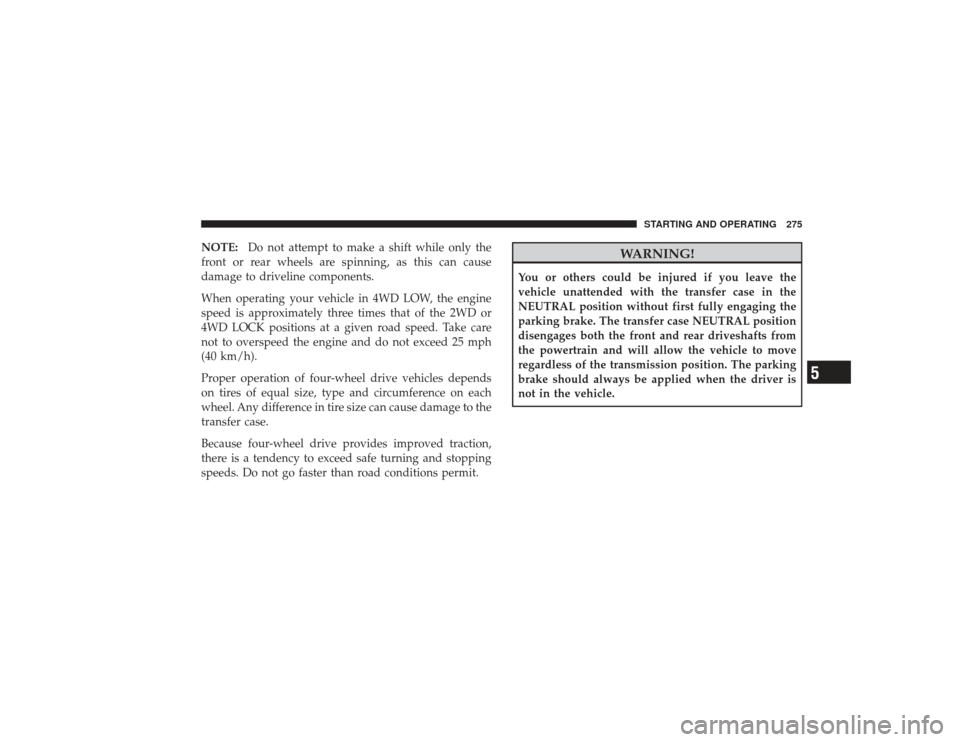
NOTE:Do not attempt to make a shift while only the
front or rear wheels are spinning, as this can cause
damage to driveline components.
When operating your vehicle in 4WD LOW, the engine
speed is approximately three times that of the 2WD or
4WD LOCK positions at a given road speed. Take care
not to overspeed the engine and do not exceed 25 mph
(40 km/h).
Proper operation of four-wheel drive vehicles depends
on tires of equal size, type and circumference on each
wheel. Any difference in tire size can cause damage to the
transfer case.
Because four-wheel drive provides improved traction,
there is a tendency to exceed safe turning and stopping
speeds. Do not go faster than road conditions permit.
WARNING!
You or others could be injured if you leave the
vehicle unattended with the transfer case in the
NEUTRAL position without first fully engaging the
parking brake. The transfer case NEUTRAL position
disengages both the front and rear driveshafts from
the powertrain and will allow the vehicle to move
regardless of the transmission position. The parking
brake should always be applied when the driver is
not in the vehicle.
STARTING AND OPERATING 275
5